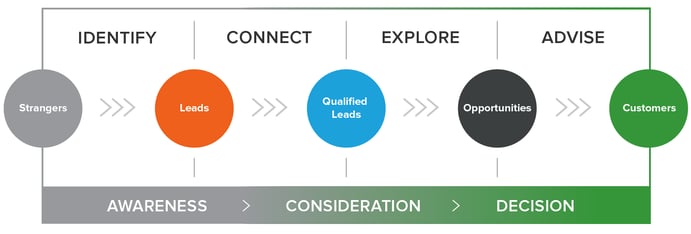What would marketing be without its counterpart, selling? The answer is that it would be pretty much pointless. Why get leads if you can’t close them into customers? So how do you as a salesperson close leads into customers in this internet age where we all do so much research and relationship building online?
For the salesperson of the twenty-first century, you do it by following the inbound sales methodology. So before we dive into the nuts and bolts of what that entails, you might be wondering, what’s the difference between an inbound and outbound sales approach? The answer is the buyer’s journey. Inbound sales representatives know the criteria that makes someone a good fit for their business like an outbound sales rep, but they prioritize buyers active in the buyer’s journey over those who are not. Now let’s dive into each key stage in the methodology.

Identify
The first step in inbound sales is to identify the strangers you want to become customers. You can’t send your content blindly to everyone you can find. That’s called cold calling and it is just as likely to alienate your potential leads as bring them in. You need to find out who among your lists of people would actually benefit from your product or service. If you can identify them and start making contact, you’ll start to convert those strangers into leads and opportunities.
With the idea in mind that you need to pursue the customers who would actually be interested in what you offer, turn again to those customers who are actively pursuing your help through content. Think of it like a hierarchy of priority: the people with the most want and need are at the very top of the list of people you should make contact with, while the people who don’t even have you on their radar are at the bottom. The most common place your customer will be when you find them is in the awareness stage of their buyer’s journey, those timid first steps after admitting that there’s a problem which you could be able to solve.
If you want some help figuring out who you should be prioritizing, then look to your buyer personas. If you need a few startup tips on how to do that, or just a quick refresher, check out these buyer persona basics. Your personas will tell you exactly who it is you want on your radar as a potential lead, so that you can limit your initial search base to just the cream of the crop. Only after your first picks are chosen and the attempts made to connect should you move down the hierarchy of those active in the buyer's journey.
Connect
Connecting is the second step when it comes to converting your customers. After identifying them, listing them, and making sure that they are in fact potential leads, you need to connect on a deeper level to turn them into qualified leads. You already know who they are and why they need your product, but now you need to help them to figure that out.
Yes, your buyer personas are back again. There is no end to why creating an ideal persona is so important because every decision you make will need to be related to them. If you can’t connect with your ideal buyers, then what chance do you have of connecting with real customers? When you’re sure you can actually connect with the personas you want, you then need to come up with a sequence you can use to bring them further along in the buyer’s journey. This should take them out of the awareness stage and into the consideration stage. There they will be thinking not about what their problem is, but about who can help them. Your goal is to convince them that you are that person, if it is indeed a good fit.
You need to supply your prospects with the information they need and want. Connect with them through emails, calls, blogs, social media, or any one of a dozen other options. Make sure your content is high quality. When you do, you can bring them closer to choosing you as their company.
Explore
With your leads turned to qualified leads you know exactly what they want and how you can supply it. Now it is time to explore the circumstances of their purchase. You need to know why your potential customer wants your product, the reasons behind that want, and what motivates them to make a purchase. This information needs to be generated quickly. With all of this data you’ll be able to better tailor your sale and take them from consideration into the decision stage of the buyer’s journey.
Personalization is one of the key factors of a good inbound strategy, and making the buyer feel like the experience has been tailored to fit him or her is exactly what you want. You want there to be a personal relationship being nurtured with every interaction with your potential buyer, because if they end up as your friends then they’re more likely to keep doing business with you rather than your competition. Give the customer every reason to trust you by giving them an honest assessment of your relationship and whether or not you think you’re the right fit for their needs. If you aren’t the right fit, your customer has just as much a right to know as anyone else. If you are the one to tell them, they will be more likely to trust and return to you when the problems they have reflect what you can give them.
But there is a time when you are the right fit for your buyer, and you will convert those customers that are qualified leads into opportunities. When you have exactly what they need and you have shown them you are their best option, it brings them close to a decision and your work as an inbound salesman is nearly finished.
Advise
 Now that you’ve enticed your prospect and determined it's a good fit for both parties, you need to hash out the details and close the deal. What you need to do now is make a presentation, proposal, contract, or something else that reflects everything you’ve worked to learn about your new client and all that you’ve talked about up to this point. You need to let them know that you care about the issues that they have, and they are the sole focus of your attention.
Now that you’ve enticed your prospect and determined it's a good fit for both parties, you need to hash out the details and close the deal. What you need to do now is make a presentation, proposal, contract, or something else that reflects everything you’ve worked to learn about your new client and all that you’ve talked about up to this point. You need to let them know that you care about the issues that they have, and they are the sole focus of your attention.
Personalization is always a key concept when it comes to inbound selling, and this stage of the process is no different. People like to feel like they matter, that you care about their stories and their problems, and that you truly listened to their needs and challenges. That is what the advise portion of inbound selling is all about. You’ve listened to everything that the customer has told you they both want and need, and now it is your job to tell them exactly what they said and how you can help them get it.
Customers
If you do it right, the prospects that you can help will have gone through the buyer’s journey and found that all of the problems they had when they started their search have been addressed. Your job throughout this process has been to maintain a good relationship with them, keep them happy, and keep them focused on your ability to help them where that is true. If done right, your prospects that turn into clients will thank you for the great sales experience, thank you for the new relationship, and be excited to work with you and your company.
Posted by Kevin Glancy

Kevin Glancy is an east coast transplant who has had a taste of the inbound Kool-Aid and is pumped to share how it can help your business grow. He loves video games, a good laugh, and enlightening conversations.


 Email
Email Facebook
Facebook LinkedIn
LinkedIn